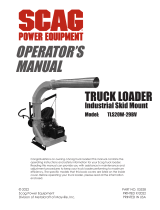
5
Section 2
2.4 TESTING THE SAFETY INTERLOCK
SYSTEM
The safety interlock system should be tested each time
before using the machine. If the safety interlock system
does not operate as described below, contact your local
Authorized Scag Power Equipment Dealer immediately to
have the safety interlock system repaired.
1. Sit in the seat in the operating position, engage the
parking brake, place the steering control levers in
the neutral lock position, and engage the PTO switch
to the ON (up) position. Try to start the engine; the
engine should not start.
2. Sit in the seat in the operating position, engage the
parking brake, move either of the steering control
handles out of the neutral lock position, move the
PTO switch to the OFF (down) position. Try to start
the engine; the engine should not start. Repeat for
the other steering control lever.
3. Sit in the seat in the operating position, disengage
the parking brake, place the steering control levers
in the neutral lock position, move the PTO switch to
the OFF (down) position. Try to start the engine; the
engine should not start.
4. Sit in the seat in the operating position, engage the
parking brake, place the steering control levers in
the neutral lock position, move the PTO switch to the
OFF (down) position, and start the engine. With the
engine running, release the parking brake and rise
slightly off of the seat. The engine should shut off.
5. Sit in the seat in the operating position, engage the
parking brake, place the steering control levers in
the neutral lock position, move the PTO switch to the
OFF (down) position, and start the engine. With the
engine running, engage the PTO switch to the ON
(up) position, and rise slightly off of the seat. The
engine should shut off.
6. Sit in the seat in the operating position, engage the
parking brake, place the steering control levers in
the neutral lock position, move the PTO switch to the
OFF (down) position, and start the engine. With the
engine running, move either steering control lever
out of the neutral lock position. The engine should
shut off. Repeat for the other steering control lever.
2.5 OPERATION CONSIDERATIONS
1. Know the function of all controls and how to stop
quickly.
WARNING
DO NOT operate on steep slopes. To check a slope,
attempt to back up it (with the cutter deck down).
If the machine can back up the slope without the
wheels slipping, reduce speed and use extreme
caution. Under no circumstances should the
machine be operated on slopes greater than 15
degrees. See Figure 2-4, Page 11 to determine
approximate slope of area to be mowed. ALWAYS
FOLLOW OSHA APPROVED OPERATION.
2. Reduce speed and exercise extreme caution on
slopes and in sharp turns to prevent tipping or loss
of control. Be especially cautious when changing
directions on slopes.
3. Stay at least 2 cutting widths away from drop-offs,
ditches, retaining walls, water, avoid any slope
exceeding 15-degrees, and do not mow under trees
on slopes with the roll bar down.
4. To prevent tipping or loss of control, start and stop
smoothly, avoid unnecessary turns and travel at
reduced speed.
5. If the operator were to lose steering control of the
mower while operating, move both steering levers
to the neutral position and immediately apply the
parking brake. Inspect the machine and correct the
problem before continuing to operate.
6. When using any attachment, never direct the
discharge of material toward bystanders or allow
anyone near the machine while in operation.
7. Before attempting to start the engine, with the
operator in the seat, disengage power to the cutter
deck, place the steering control levers in the neutral
position and engage the parking brake.
8. If the mower discharge ever plugs, shut off the
engine, remove the ignition key, and wait for all
movement to stop before removing the obstruction.
WARNING
DO NOT use your hand to dislodge the clogged
discharge chute. Use a stick or other device to
remove clogged material after the engine has
stopped running and the blades have stopped
turning.
































